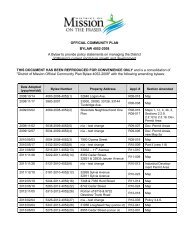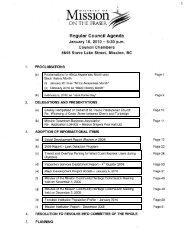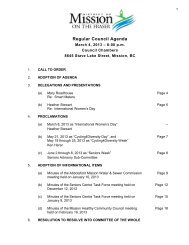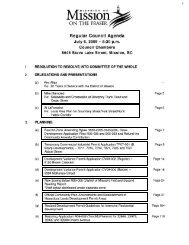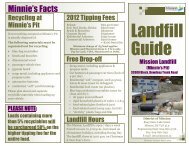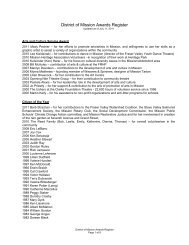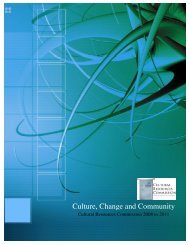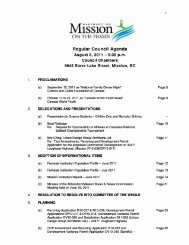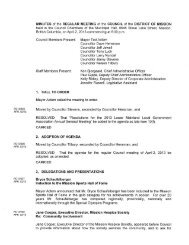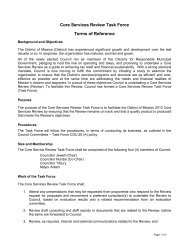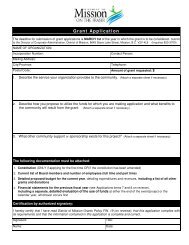June 15, 2009 - District of Mission
June 15, 2009 - District of Mission
June 15, 2009 - District of Mission
Create successful ePaper yourself
Turn your PDF publications into a flip-book with our unique Google optimized e-Paper software.
197<br />
<strong>District</strong> <strong>of</strong> <strong>Mission</strong> — 2008 Audit Results and Communication<br />
Page 18<br />
procedures) and substantive procedures (such as analysis <strong>of</strong> data and obtaining direct evidence as to the<br />
validity <strong>of</strong> the items). The substantive approach virtually ignores controls and focuses almost exclusively on<br />
tests <strong>of</strong> accounting outputs.<br />
As a result <strong>of</strong> changes to our pr<strong>of</strong>essional audit requirements in recent years, auditors must have a good<br />
understanding <strong>of</strong> the control systems. Having said that, the level <strong>of</strong> understanding required for audit purposes<br />
is not sufficient for us to provide opinion on the overall effectiveness <strong>of</strong> the internal control environment.<br />
Therefore our audit process will involve a fair degree <strong>of</strong> systems work coupled with verification <strong>of</strong> key<br />
balances by substantive means.<br />
Higher Risk Financial Statement Areas<br />
Based on our knowledge <strong>of</strong> the <strong>District</strong>'s operations, past experience with similar organizations, and<br />
knowledge gained from management and you, we have identified the following financial statements areas as<br />
having a potentially higher risk <strong>of</strong> material misstatement.<br />
These risks arise mainly because <strong>of</strong> the complexity <strong>of</strong> the accounting rules, the extent <strong>of</strong> estimation and<br />
judgment involved in the valuation <strong>of</strong> these financial statement areas, and the existence <strong>of</strong> new accounting<br />
pronouncements that affect them. We have also provided a brief summary <strong>of</strong> how we plan to audit these<br />
higher risk areas:<br />
Higher Risk Financial Statement Areas<br />
Proposed Audit Procedures<br />
• Provision for retirement • Audit <strong>of</strong> significant assumptions<br />
• Review <strong>of</strong> calculations<br />
• Tangible Capital Assets • Assessment <strong>of</strong> status to date and <strong>of</strong> future<br />
plans to comply with upcoming accounting<br />
and disclosure requirements<br />
• Review the reasonableness <strong>of</strong> the <strong>District</strong>'s<br />
processes for gathering tangible capital<br />
assets inventory and approaches to<br />
valuation <strong>of</strong> the assets<br />
Higher Risk Financial Statement Areas<br />
Proposed Audit Procedures<br />
• Accounts payable • Third party confirmation<br />
• Computer audit testing<br />
• Cut-<strong>of</strong>f testing<br />
• Cash and investments • Confirmation <strong>of</strong> cash and investments<br />
• Review <strong>of</strong> reconciliations<br />
• Review <strong>of</strong> reports on return and investment<br />
strategies<br />
• Testing <strong>of</strong> investment transactions and<br />
investment rollovers



